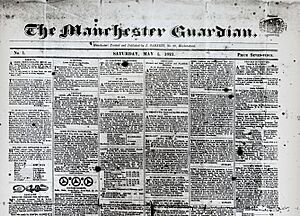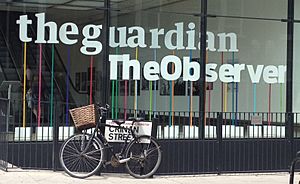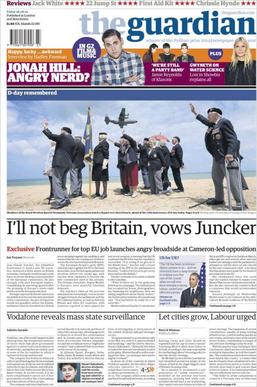The Guardian facts for kids
 |
|

Front page on 22 July 2025
|
|
| Type | Daily newspaper |
|---|---|
| Format | Broadsheet (1821–2005) Berliner (2005–2018) Compact (since 2018) |
| Owner(s) | Guardian Media Group |
| Founder(s) | John Edward Taylor |
| Publisher | Guardian Media Group |
| Founded | 5 May 1821 (as The Manchester Guardian, renamed The Guardian in 1959) |
| Political alignment | Centre-left |
| Language | English |
| Headquarters | Kings Place, London |
| Country | United Kingdom |
| Circulation | 105,134 (as of July 2021) |
| Sister newspapers | The Observer (1993-2025) The Guardian Weekly |
| ISSN | 0261-3077 (print) 1756-3224 (web) |
| OCLC number | 60623878 |
The Guardian is a daily newspaper from the United Kingdom. It started in 1821 in the city of Manchester, where it was called The Manchester Guardian. In 1959, it changed its name to The Guardian and later moved to London. The newspaper is known for its centre-left political views, which means it often supports ideas of social equality and government support for citizens.
The Guardian is owned by the Scott Trust Limited. This trust was set up in 1936 to make sure the newspaper could report the news freely, without pressure from businesses or politicians. Any money the newspaper makes is put back into its journalism instead of being paid to owners. This makes it different from many other news companies.
The newspaper is printed from Monday to Saturday. It also has a very popular website with different versions for the UK, the United States, Australia, and Europe. Many people trust The Guardian. In 2018, a poll found it was the most trusted online news source in the UK.
The Guardian is famous for its investigative journalism, which means its reporters uncover secret or important information. One of its biggest stories was in 2013, when it published secret files from Edward Snowden. These files showed how governments were collecting information from people's phone calls and internet use.
Contents
History of The Guardian
The Manchester Guardian was started in 1821 by a cotton merchant named John Edward Taylor. He and his business partners wanted a newspaper that supported their values. At the time, Manchester was a major center for the cotton industry.
The newspaper's first edition said it would support "civil and religious Liberty" and "the cause of Reform." However, it was often critical of workers who went on strike for better pay and conditions.
The American Civil War
During the American Civil War (1861–1865), Britain was divided. The Guardian had complex views. It was against slavery but was not always supportive of President Abraham Lincoln. The newspaper was worried about the war's effect on the cotton trade, which was vital to Manchester's economy.
The war caused a "cotton famine" in Britain because supplies from the American South were blocked. This caused great hardship for workers in towns like Manchester. Despite this, many workers supported Lincoln and the Union's fight against slavery. When Lincoln was assassinated in 1865, the newspaper reported on the sad event.
C. P. Scott's Leadership
C. P. Scott was the editor of the paper for 57 years, starting in 1872. He later bought the newspaper in 1907. Under his leadership, The Guardian became famous across the country. Scott made the paper's views more progressive. For example, he supported the movement for women's suffrage, which was the right for women to vote.
In 1936, ownership of the paper was passed to the Scott Trust. This was created to protect the newspaper's independence and make sure it could continue to report freely.
The Spanish Civil War
During the Spanish Civil War (1936–1939), The Guardian supported the elected Republican government against the rebel forces of General Francisco Franco. Its reporting earned it respect from many people on the left. The famous writer George Orwell praised the newspaper for its honesty during this time.
Moving to London
On August 24, 1959, The Manchester Guardian officially changed its name to The Guardian. This showed that the newspaper was covering more national and international news. In 1961, it also started printing in London, which became its new home.
Major News Stories
The Guardian has a history of publishing "scoops," which are exclusive and important news stories.
The Phone-Hacking Scandal
In 2011, The Guardian uncovered a major scandal. It revealed that journalists at the News of the World newspaper had been illegally listening to the voicemails of many people. This included celebrities, politicians, and even a murdered teenager named Milly Dowler. The investigation led to the closure of the News of the World, which had been one of Britain's most popular newspapers.
Edward Snowden's Leaks

In 2013, The Guardian published a series of explosive articles based on documents leaked by Edward Snowden. Snowden was a former contractor for the U.S. National Security Agency (NSA). His documents revealed that the U.S. and UK governments were secretly collecting huge amounts of data from phone calls and online activity.
The British government was not happy about these reports. Agents from its intelligence agency, GCHQ, visited The Guardian's office and supervised the destruction of the computers that held the Snowden files. However, the newspaper had already sent copies of the files to its American office. For its work on this story, The Guardian US won a Pulitzer Prize, a top award in American journalism.
Panama Papers
In 2016, The Guardian was part of a global investigation into the Panama Papers. This was a huge leak of documents from a law firm in Panama. The papers showed how many wealthy and powerful people around the world used offshore accounts to manage their money.
Political Views
The Guardian is known for its liberal and centre-left viewpoint. This means it generally supports progressive ideas like social justice, environmental protection, and government programs that help people.
The newspaper's readers are mostly on the left of British politics. A poll in 2005 found that most of its readers voted for the Labour Party or the Liberal Democrats. The term "Guardian reader" is sometimes used as a stereotype for someone with liberal or "politically correct" views.
Although it is often seen as a Labour-supporting paper, The Guardian has sometimes been critical of the party. In the 2010 general election, it supported the Liberal Democrats because of their promise of electoral reform. In the 2015, 2017, and 2019 elections, it switched its support back to Labour.
Ownership and Finances
The Guardian is owned by the Guardian Media Group (GMG). This group is, in turn, owned by the Scott Trust. The trust's main goal is to ensure the newspaper remains editorially independent forever. This means no single person or company can buy it and change its reporting to suit their own interests.
For many years, the newspaper lost money. It was supported by other, more profitable businesses within the GMG. To secure its future, the group sold off these other businesses. By 2014, it had a large fund of over £800 million to support the newspaper.
In 2019, for the first time in many years, The Guardian announced that it had broken even, meaning its costs were covered by its income. This was partly thanks to its "membership" scheme. The newspaper does not have a paywall, so anyone can read its articles for free online. Instead, it asks readers for voluntary contributions to support its journalism. By 2018, over one million people were supporting the paper through donations or subscriptions.
Newspaper Formats
The Guardian has changed its physical size and shape several times.
- Broadsheet (1821–2005): For most of its history, it was a large-format newspaper called a broadsheet.
- Berliner (2005–2018): In 2005, it became the first UK newspaper to switch to the Berliner format. This was a medium size, popular in Europe. The change cost £80 million because it required new printing presses.
- Tabloid (2018–present): In 2018, the paper switched to a smaller tabloid format to cut costs. This allowed it to be printed on more common presses.
Online Presence
The Guardian's website, TheGuardian.com, is one of the most popular news websites in the world. All of its articles are available for free. The website has different editions for the UK, US, Australia, and Europe, with news tailored to each audience.
The newspaper has also been a leader in digital journalism. It launched a podcast by comedian Ricky Gervais in 2005, which became the most downloaded podcast in the world at the time. Today, its daily news podcast, Today in Focus, is very popular in the UK.
In 2024, The Guardian announced it would stop posting its articles on the social media platform X. The newspaper said this was because of the large amount of false information and hate speech on the site.
Images for kids
See also
 In Spanish: The Guardian para niños
In Spanish: The Guardian para niños







